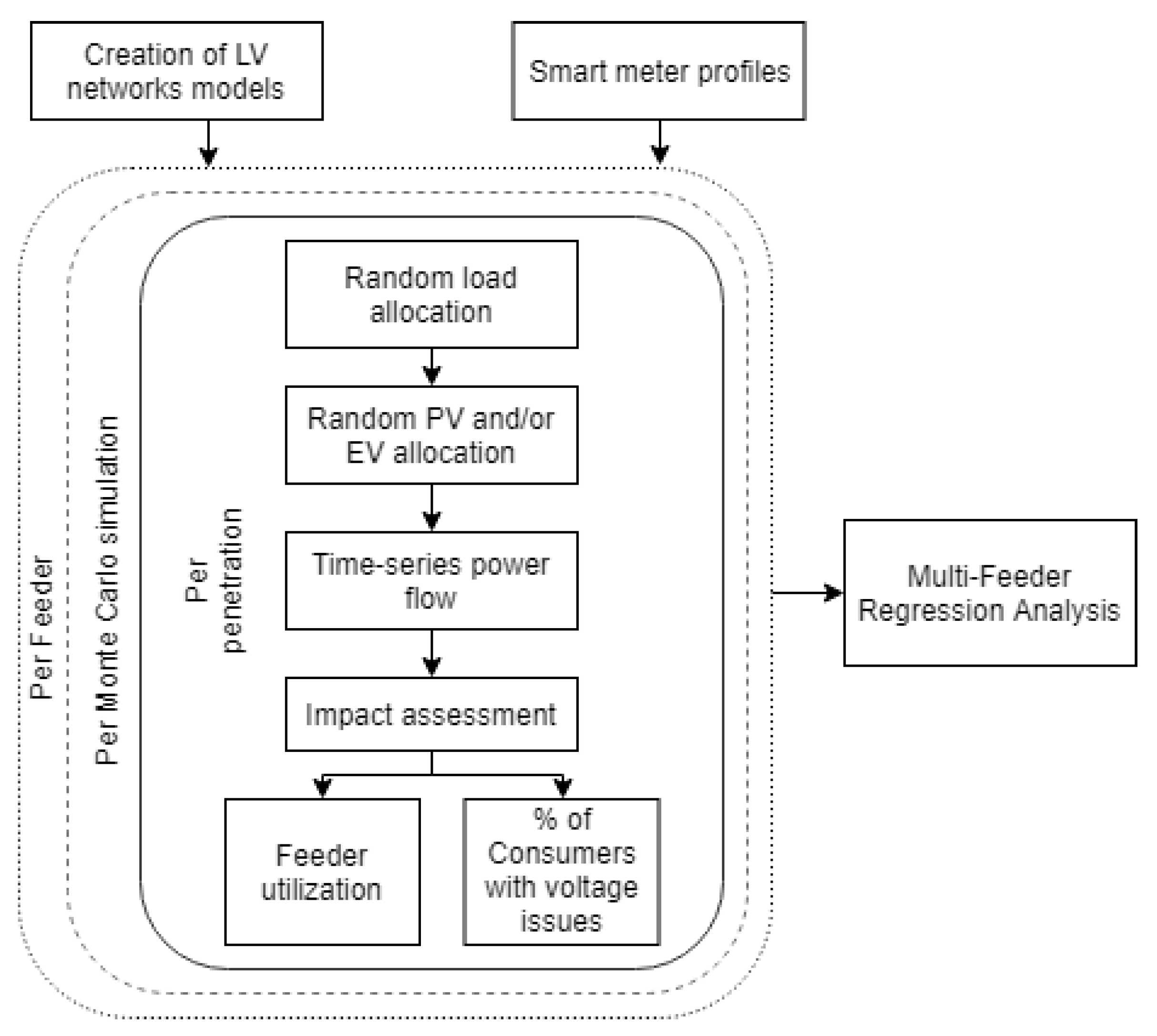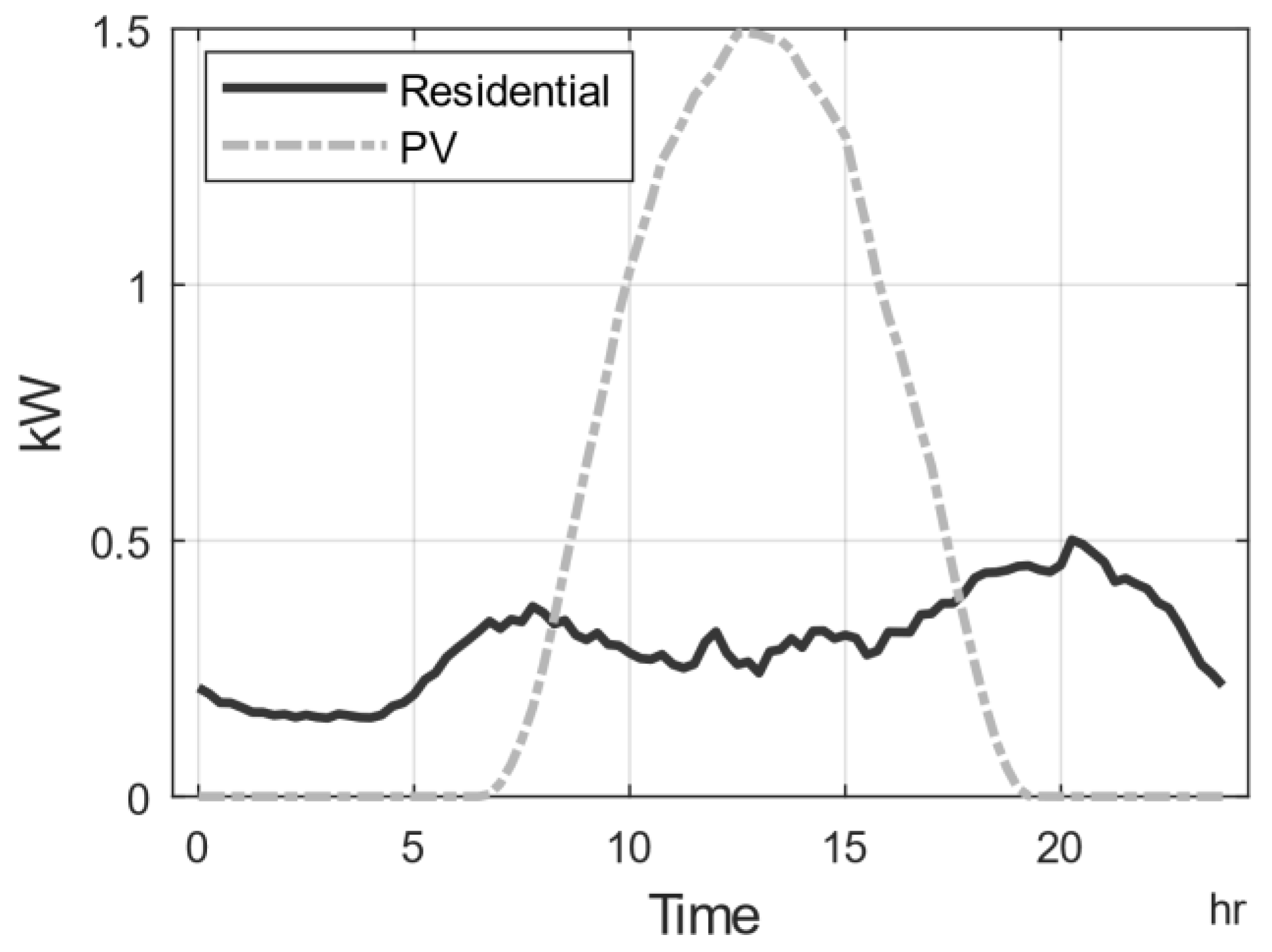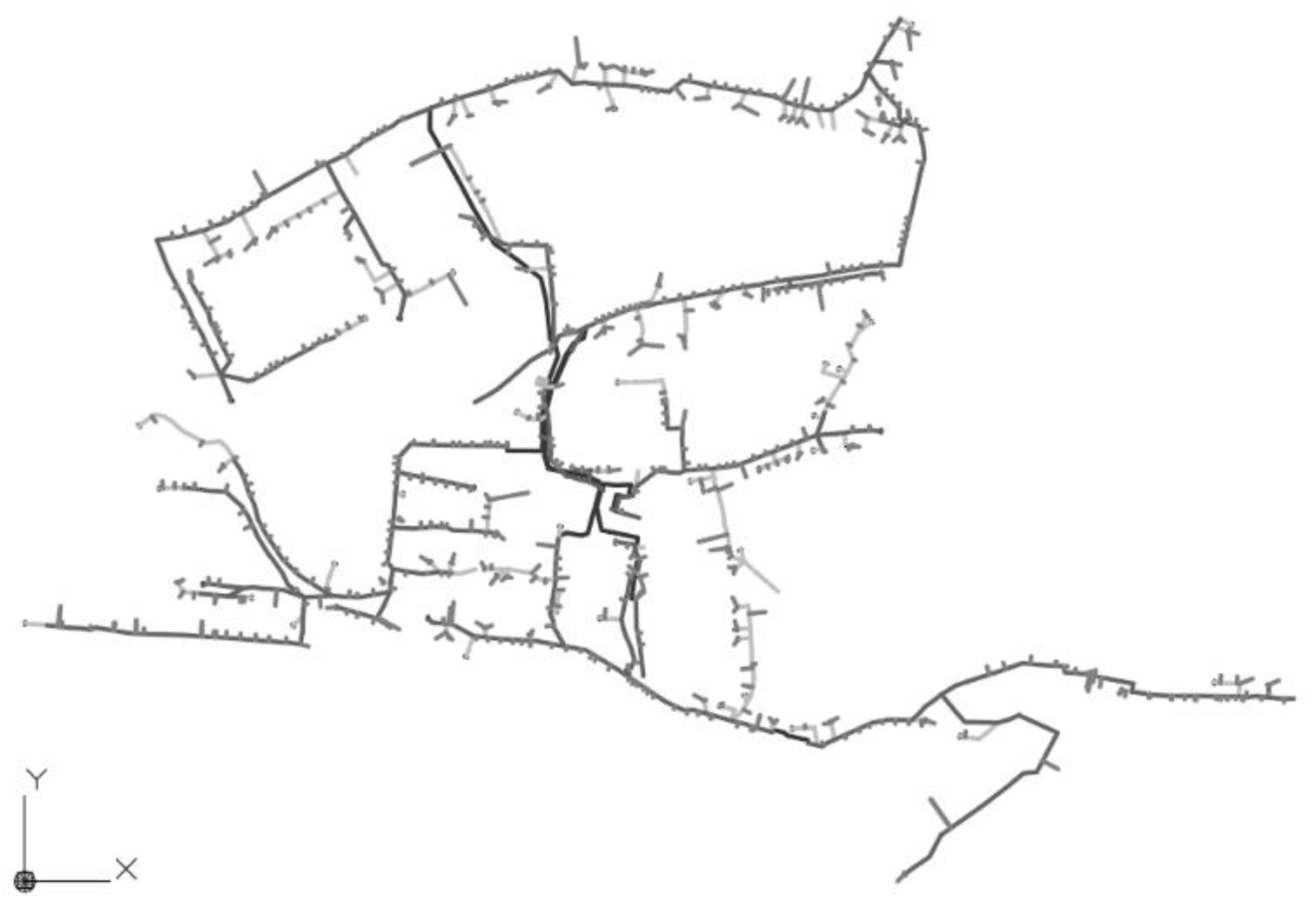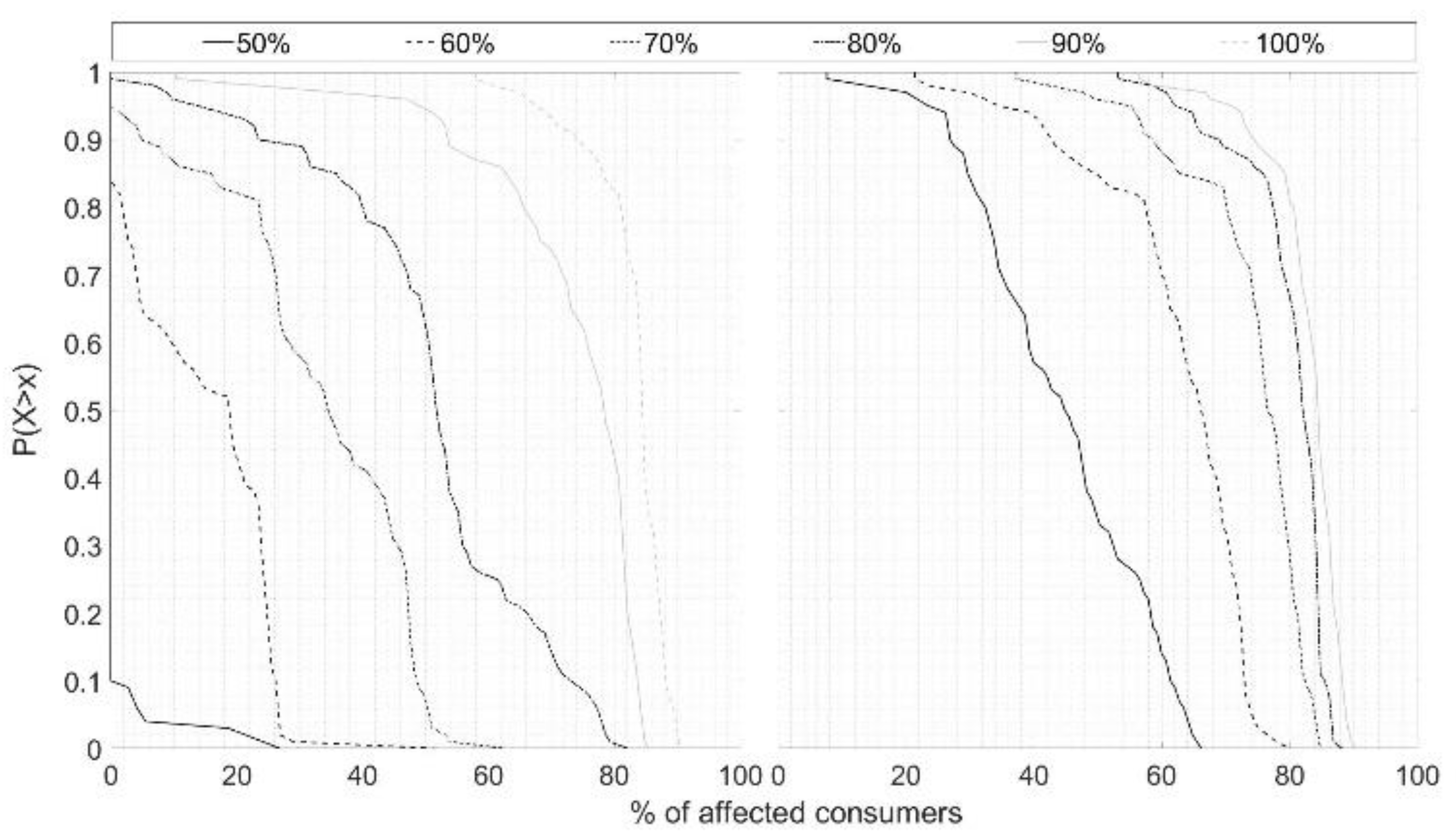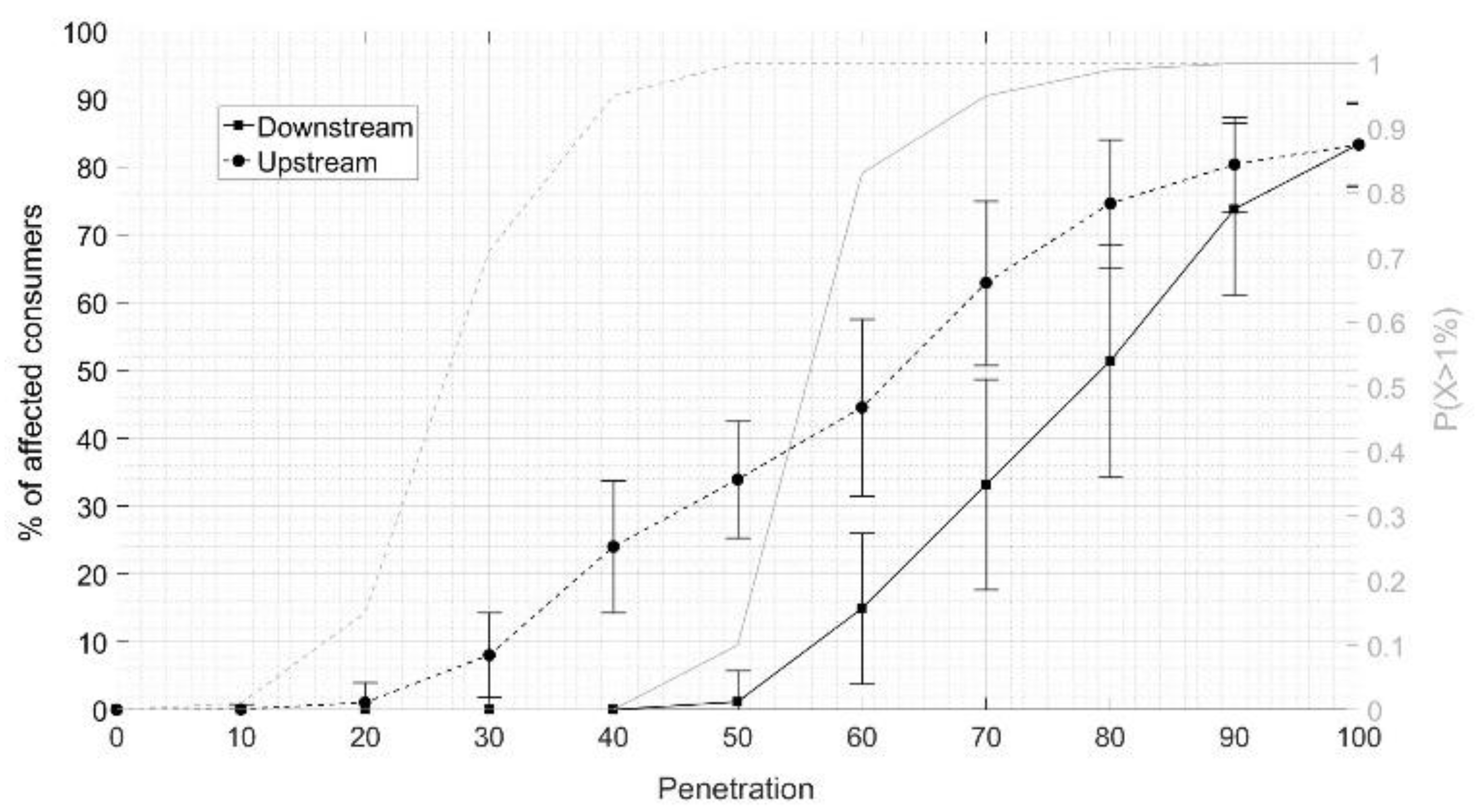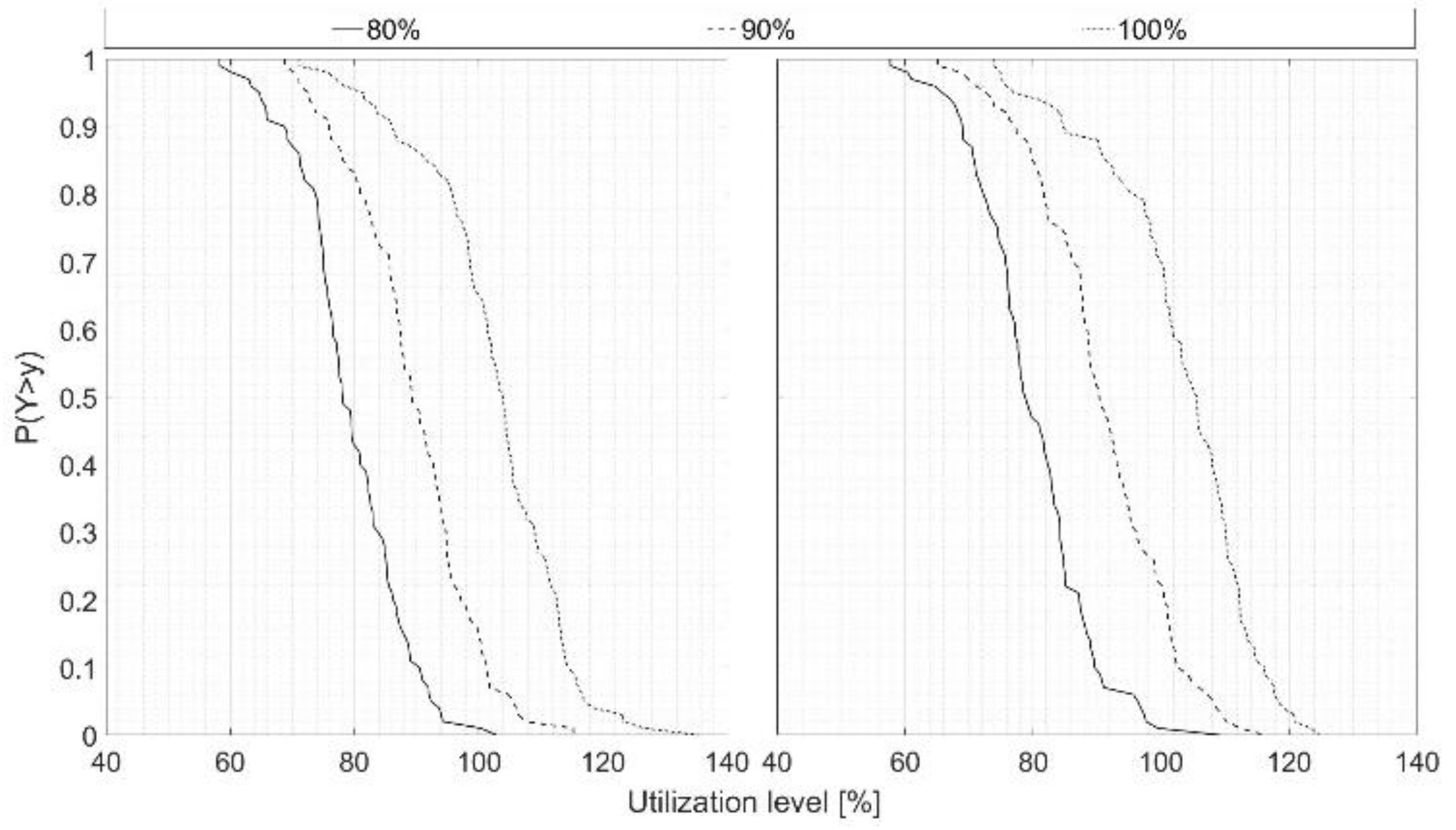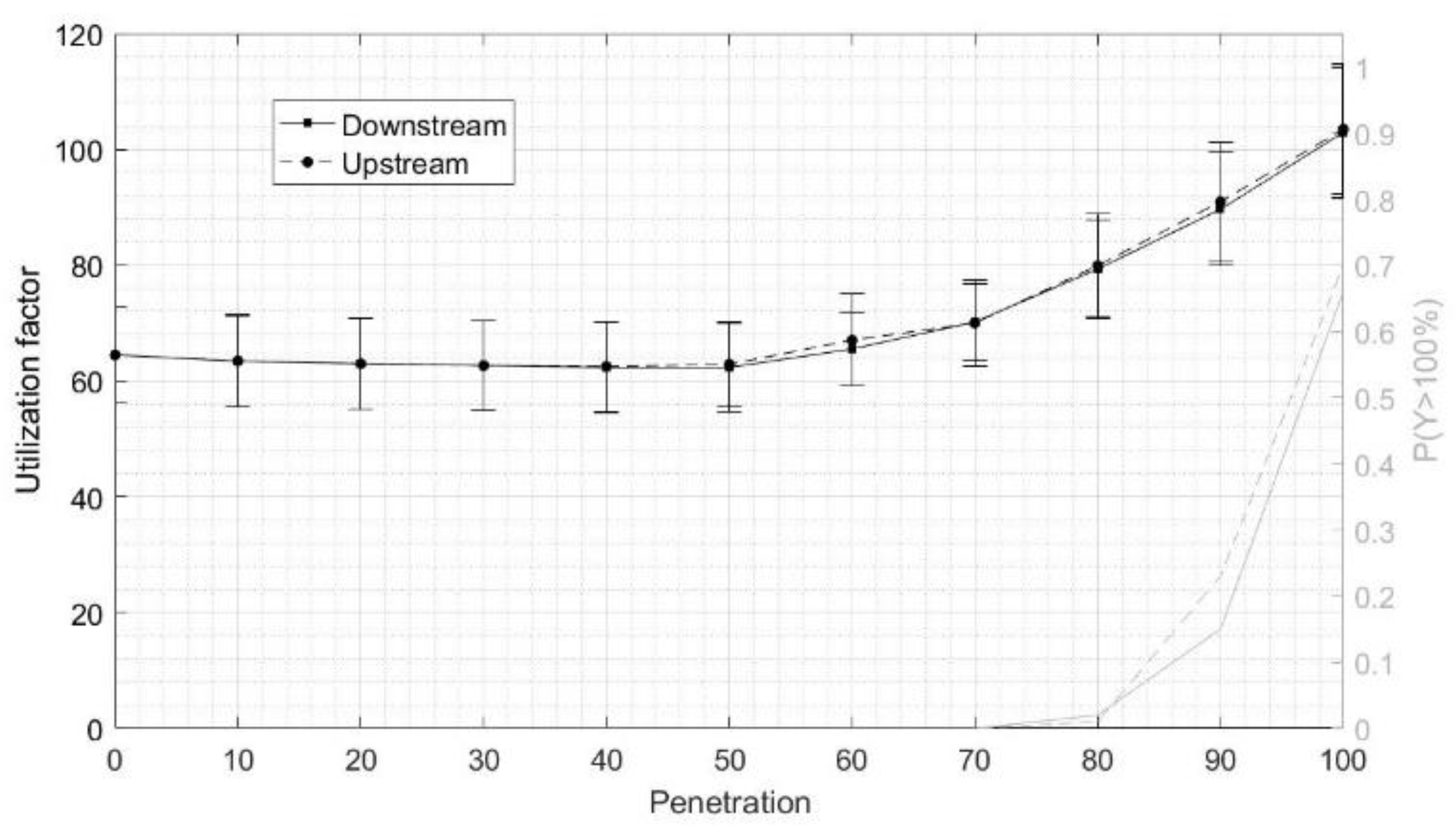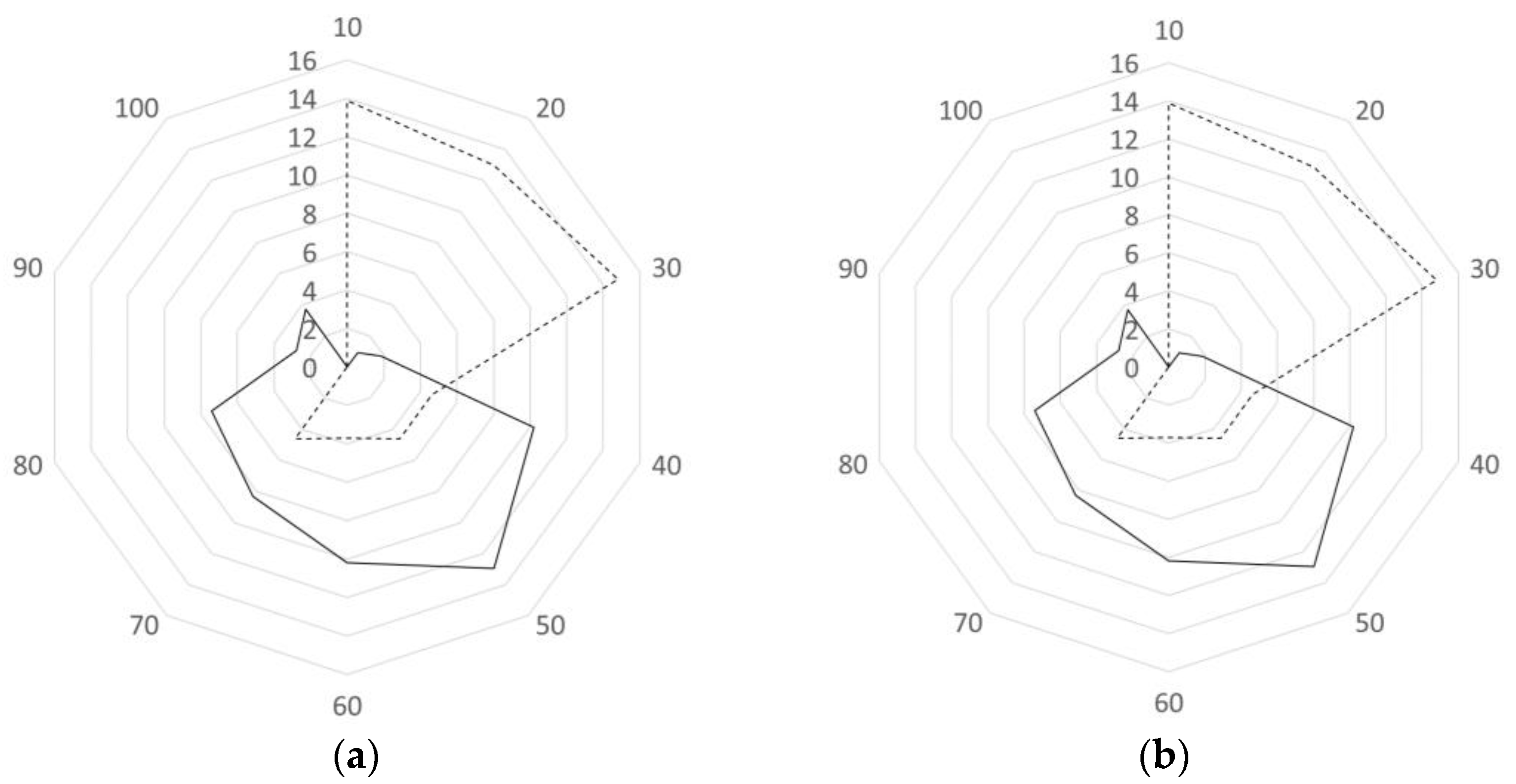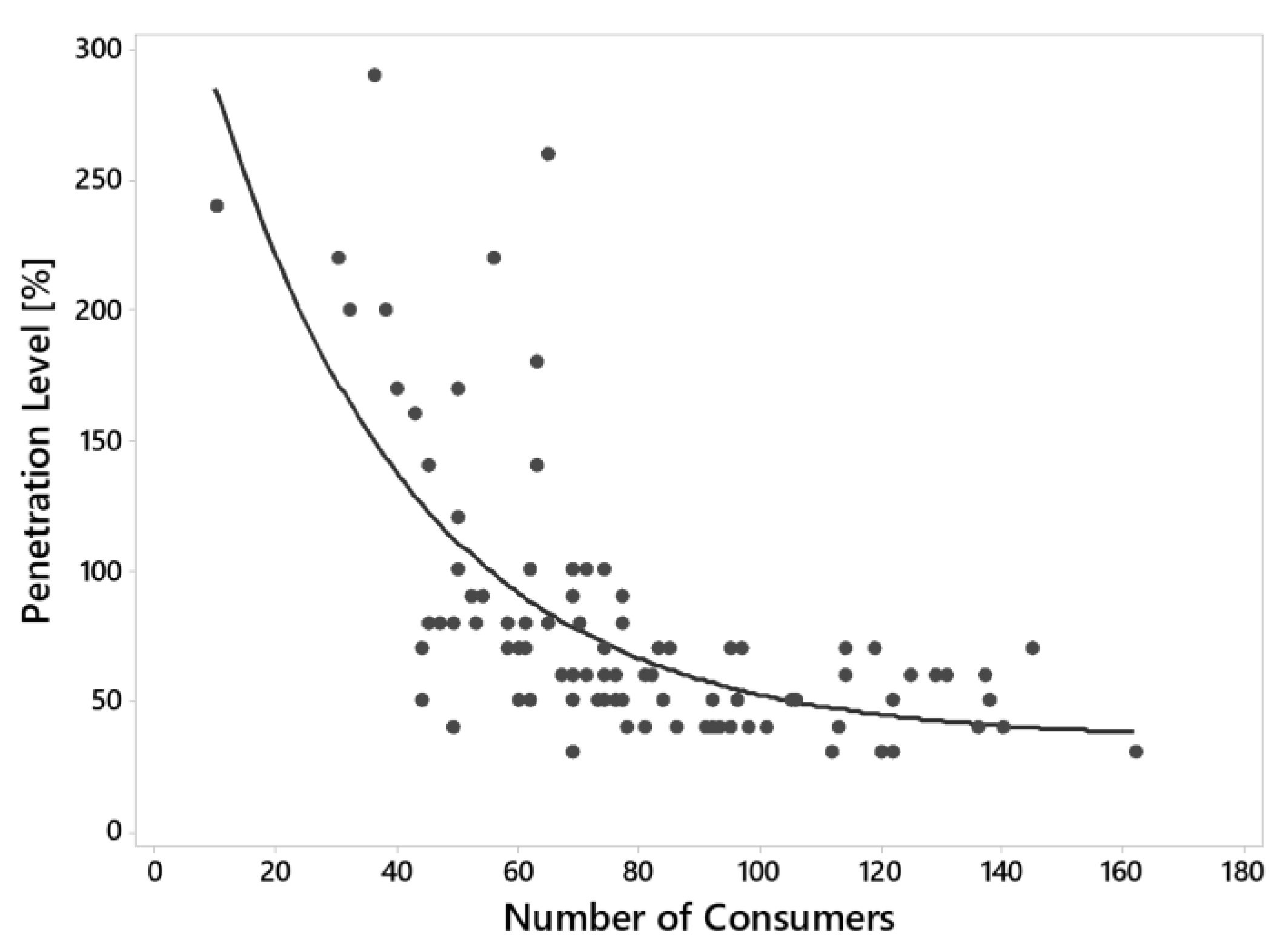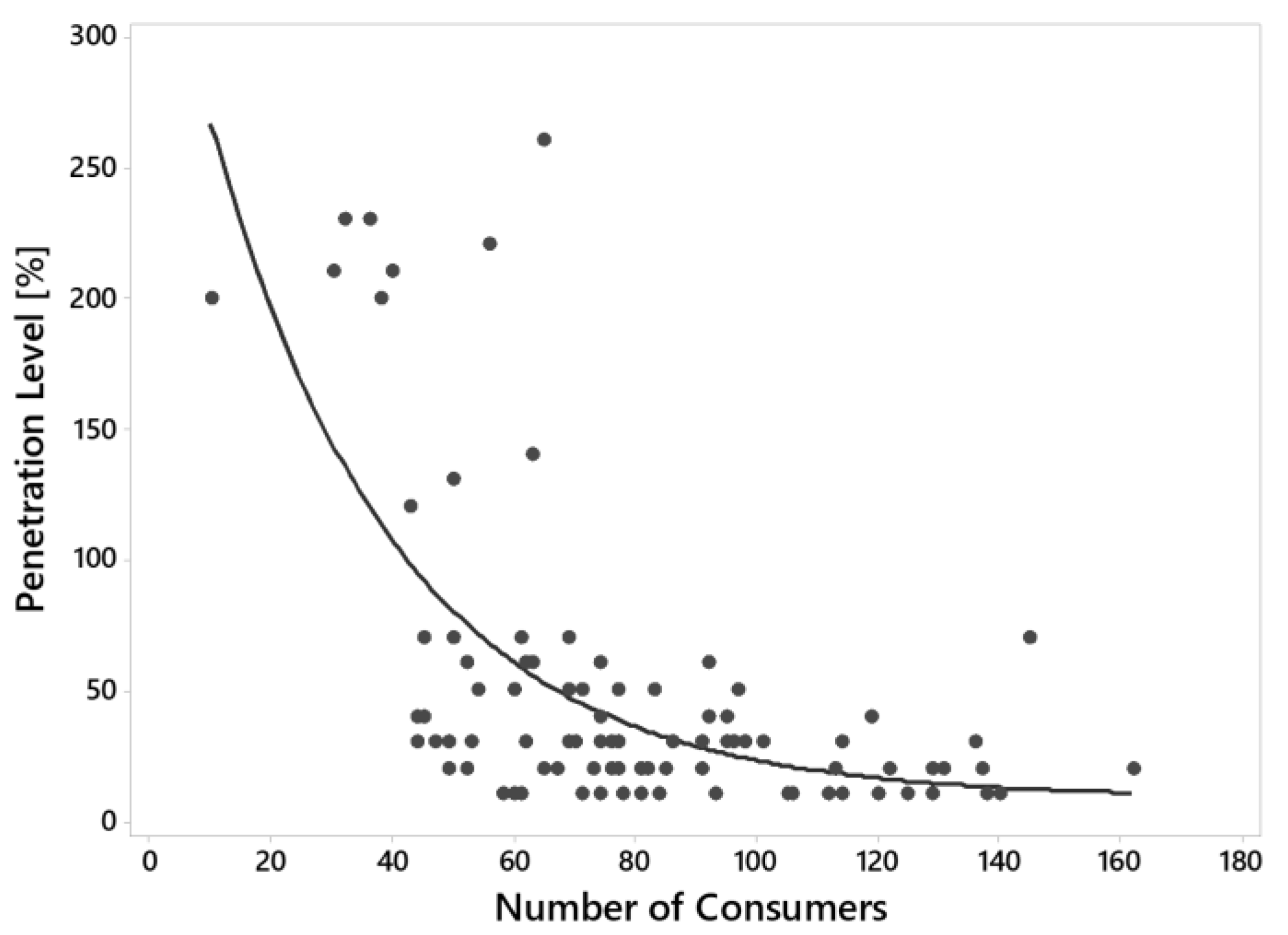1. Introduction
FUTURE-PROOF electrical energy and power networks have become more sustainable with well-integrated Distributed Generation (DG) units [
1]. Decarbonization, digitalization, decentralization, and disintermediation are key drivers of disruption for energy utilities. The voltage variation and feeder utilization level in Low Voltage (LV) electric networks (<1 kV) are the first major challenges addressed by these utilities. These challenges are especially exhibited during peak DG generation, and low consumption causes reverse power flows that may degrade the network stability [
2], raise voltages [
3,
4,
5,
6,
7,
8,
9,
10,
11,
12,
13], and cause overloading [
7,
9,
10].
Photovoltaic systems (PVs) are extremely promising low-carbon technologies playing a major role in the electricity industry. The PV market has the fastest annual growth rate—around +30% [
14]. The EU’s PV capacity increased to 166 GW in 2021, which is around 17% of globally-installed PVs [
15]. Therefore, unique impact studies based on large electric networks that consider real-case scenarios and smart meter data can enrich our insights on PV integration in LV distribution networks. These studies are especially important in Malta, a solar country that has set its PV support programme as the most proven to expand the PV market. The Maltese PV support programme guarantees tariffs to all potential developers and attractive financial security that covers developers’ costs with long-term certainty [
16].
Located centrally in the Mediterranean Sea, Malta is the southern-most EU country and receives the highest EU solar irradiance. As an island state, Malta represents a unique scenario with its 316 km
2 surface area, dense population of 1300 pp/km
2, and over 300,000 utility customers that enjoy being the first nation to roll out smart meters worldwide. PV installations have reached 184.6 MWp of the total PV capacity, and are mostly from residential units that are usually less than 3.1 kWp systems connected to LV networks [
17].
While a variety of definitions of high penetration are suggested, throughout this work, the term ‘high penetration’ will be used to refer to the level at which an electric distribution network has a high probability of experiencing thermal and voltage violations. The penetration level in this paper is defined as the number of consumers with PV connected to the total number of consumers. No PV case means 0% penetration, whereas if all houses were to integrate PV, the penetration level would be 100%.
Many studies have investigated the potential impacts of PV integration on distribution networks. A summary of some of the studies are shown in
Table 1. For instance, the impacts of PV integration on voltage profile and feeder utilization were assessed, respectively.
However, most studies were carried out on representative networks [
3,
6,
8,
11,
12,
18]. Representative network studies provide a basic understanding of the problems that may occur but cannot be applied to other networks. In addition, it does not provide information on the proportion of LV networks experiencing technical problems.
Furthermore, these studies [
3,
4,
6,
7,
8,
9,
10] were based on solar irradiance measurements, which are not always available for utilities and do not consider the efficiency of cells.
Based on this review, the following considerations are outlined to investigate the impacts of PV integration on LV networks adequately:
- i.
Realistic and adequate LV networks based on the geographical region of interest;
- ii.
Time-series analysis to cater to the time-varying nature of residential loads and PVs;
- iii.
Multiple LV feeders’ analysis to cater to their diversity; this will allow for the analysis of the parameters of the feeders that can explain the occurrence of technical problems.
Using Monte Carlo methods, this work embeds the uncertainties of residential loads and PVs related to size and behaviour. The real Maltese LV networks analysis considers the smart meter residential load and PV profiles in 15-min resolutions.
The aim is to deliver the first thorough case study based on smart metered home loads and PV generating profiles in Malta. The methodology uses a stochastic scenario-based Monte Carlo framework. Each scenario is evaluated for EN50160 voltage difficulties (or voltage boundaries) and feeder capacity.
The paper is structured as follows.
Section 2 describes the methodology base framework of the study. Then,
Section 3 presents the application of the methodology base framework through an impact analysis on one real-life Maltese LV network from one 11/0.4 kV substation with 7 LV feeders. The likelihood of LV Network challenges is discussed through the extracted Cumulative Distribution Function (CDF) within the Monte Carlo methods in
Section 4. Afterwards, the comprehensive real-life Maltese 95 LV multi-feeder impact analysis results are presented and discussed in
Section 5. Then, in
Section 6, a regression analysis tool and its results are highlighted. Finally,
Section 7 presents the main conclusions and a key finding that is distinctive from previous studies on the inadequate metric for non-linear regression.
2. The Methodology-Based Framework
OpenDSS performs a three-phase unbalanced time-series power flow [
19].
Figure 1 depicts the framework for studying PV penetration on LV networks based on size and behaviour uncertainties. First, LV feeder computer models are created, and then smart meter load and PV profiles are loaded. A Monte Carlo simulation is run for a specified feeder. Multiple power flows for each PV penetration (from 0% to 100% in 10% steps) are evaluated. Each power flow study uses a random load and PV profile from the pool of profiles. Each simulation’s effect analysis measure (utilization factor, proportion of users with voltage issues) is saved. Furthermore, the model is finalized by correlating many feeders to find feeder attributes that may explain technical concerns.
2.1. Smart Meter Profiles
The widespread use of PV systems necessitates a clear need for the long-term knowledge of LV networks. In the world’s first deployment of a nationwide smart meter infrastructure, Malta’s energy company, Enemalta plc, reached 90% of its customers by 2014. Enemalta plc is the owner and manager of the LV networks.
Based on data provided by smart meters, a probabilistic methodology was used in this study [
11,
20], and solar irradiance measurements were not used, like in the studies from [
3,
4,
6,
7,
8,
9,
10]. The profiles comprise 2000 PV profiles and 5000 residential, domestic, and commercial loads.
Figure 2 presents the average profile for residential consumers and PV generation.
Weekdays often have low noon demand, which falls during the peak time for PV generation. These circumstances present the grid with its most significant challenge regarding voltage stability since they could result in reverse power flows that go up toward the transformer. After reviewing the data profiles, a day in April was selected since April is a month with high PV generation due to favourable weather. It is sufficient to depict the worst-case scenario of PV generation. Hence, only one day was used in the simulation.
2.2. Impact Assessment
The methodology outlined in this work employs Monte Carlo simulations to account for PVs’ size and behaviour uncertainties. For the following two PV allocation scenarios, 100 simulations were conducted with 11 penetration levels ranging from 0% to 100% in 10% increments:
- i.
Downstream: PVs are allocated from the substation down to the furthest consumer;
- ii.
Upstream: PVs are assigned from the last consumer to the transformer.
These allocation scenarios are employed to cater to worst-case scenarios to identify the boundaries of LV networks.
It is crucial to realize that because PV generation and electricity consumption vary over time, technical consequences change during the day. Therefore, when quantifying technological concerns, this needs to be taken into account. Two indices are shown in the impact evaluation for this reason.
- i.
Voltage issues: This index uses the voltage calculated for each customer to determine whether it complies with European Standard EN50160 (the voltage magnitude should be within 230 V +/− 10%) [
21], that is, the violation is flagged when the voltage is below 207 V or above 253 V. Throughout this work, the term ‘voltage issues/problems’ or ‘voltage challenges’ refers to voltage violations in terms of voltage magnitude, typically overvoltage due to reverse power flows caused by high penetration of PV integration. A consumer is said to have a problem if they are not compliant. The percentage that corresponds to the total number of consumers experiencing voltage problems is determined. Since the profiles have a resolution of 15 min, violating the restriction by even one value would be against the EN50160 standard.
- ii.
Feeder utilization: This is calculated by dividing the maximum current by the head of the feeder’s ampacity. This index illustrates how the LV feeder is used at various levels of penetration.
3. Application of the Methodology Framework
3.1. Real-Life Maltese LV Network
The impact analysis is highlighted with the application of the methodology framework for one real-life Maltese LV network from one 11/0.4 kV substation with 7 three-phase LV feeders, as illustrated in
Figure 3. The LV network’s main characteristics are listed in
Table 2 based on Geographic Information System (GIS) modelling that considered the conductor characteristics, location of consumers, phase connectivity, and network topology. LV Feeder 4 was chosen to highlight the per feeder results as it is regarded as the most loaded feeder in this case.
3.2. Summary of Results for Real-Life Maltese LV Network
Table 3 summarises the results for all seven feeders. The results depict the first occurrences of technical challenges due to PV penetration. For the utilization capacity, a 70% threshold was selected to indicate the potential limitations in headroom capacity for operational tasks.
3.3. Voltage Issues
The number and corresponding percentage of consumers with voltage issues are analyzed, and the mean value and its standard deviation are depicted using Monte Carlo simulations.
Figure 4a presents the consumers with voltage problems with different PV penetrations. The range of impacts can be clearly observed between downstream and upstream allocation scenarios. For instance, the percentage of consumers with voltage problems is below 10% and around 40% at 50% PV penetration for downstream and upstream scenarios, respectively. As can be seen, the voltage issues start, on average, at 20% and 50% PV penetration for upstream and downstream allocation scenarios, respectively.
3.4. Utilization
Figure 4b presents the average utilization factor and its corresponding standard deviation at the head of the feeder for both allocation scenarios. As expected, there is a slight variation between downstream and upstream scenarios. The initial loading level is at 70% on average. It decreases as more PV units are connected. This decrease means that the household demand is partly supplied by local generation, and reverse power flows are lower than the base case, i.e., 0% PV penetration. However, this decrease is negligible because the peaks of consumption and generation do not coincide, as presented in
Figure 2.
The utilization factor starts to increase after 50% PV penetration. At 60% penetration, the utilization exceeded the base case, meaning that reverse power flows are more significant than with no PV case. The feeder capacity is surpassed, on average, at 90% penetration.
3.5. Conclusions for Single LV Network Analysis
Although the findings are limited to only one LV network, it can be observed that relatively short feeders with few loads do not present any technical problems. On the other hand, more loaded and longer feeders are more likely to present technical challenges at some penetration level. Finally, it is important to note that until 10% penetration, no voltage and utilization problems were observed. However, to truly investigate these technical problems on different LV feeders, a multi-feeder assessment was performed in
Section 4.
4. Likelihood of LV Network Challenges
The impact analysis presented in previous sections can be extended, given its stochastic nature, by extracting the Cumulative Distribution Function (CDF) to demonstrate the probability of experiencing voltage or utilization capacity issues. This tool is used to conclude whether a given PV penetration level that causes technical problems is acceptable. Quantifying this probability can help utility companies to determine whether it is feasible to accept penetration levels that represent a low probability of technical challenges instead of investing in infrastructure.
Given empirical data, i.e., results for 100 simulations, an empirical CDF is chosen; it is similar to CDF. That is, they are both probability models for data. However, empirical CDF models observe data, whereas CDF is a hypothetical distribution model.
Empirical CDF assigns a probability of 1/n and calculates the sum of these probabilities up to and including each datum. The result is a step function increased by 1/n with each step.
To calculate this, we let X be the percentage of consumers with voltage violations.
Figure 5 illustrates the CDFs, which represent the probability of having at least x% of consumers with voltage issues for downstream and upstream allocation scenarios. For downstream allocation, it suggests that the likelihood of having more than 20% (0.2) of consumers with voltage issues is about 0.2, 0.85, and 0.95 at 50%, 60%, and 70% penetration levels. In contrast, the likelihood of no consumers with voltage issues is a probability of 0.4 and 0.75 for 50% and 20% penetration levels for downstream and upstream PV allocation scenarios.
Figure 6 presents the mean percentage of consumers with voltage violations as +/− one standard deviation on Feeder 4 and the probability of having more than 1% of consumers with voltage problems for each penetration level. For a downstream scenario, the likelihood of having more than 1% of consumers with voltage problems is around 0.1 at a 50% penetration level. In comparison, there are at least 1% of consumers with voltage issues above 70% PV penetration. For the upstream PV allocation scenario, it is a more conservative case, where a >40% penetration level always has at least 1% of consumers with voltage issues.
To calculate this, we let Y be the utilization factor at the head of the feeder. For example,
Figure 7 suggests that the probability of surpassing loading capacity (utilization factor > 1.0) is 0.55 at 90% PV penetration and 0.95 at a 100% penetration level. Meanwhile, the likelihood of surpassing the loading capacity is close to zero for 80% and 70% penetration levels for downstream and upstream PV allocation scenarios.
Figure 8 presents the probability of a utilization factor higher than 1.0 (>100%) and the average percentage of +/− one standard deviation. For a 95% PV penetration, the probability of exceeding cable ratings is about 0.5, and there is a negligible probability of occurrence before 80% penetration.
5. Multi-Feeder Impact Analysis
The first ever comprehensive real-life Maltese LV multi-feeder stochastic impact analysis results are summarised and discussed in this section.
A voltage violation is flagged if the feeder’s probability of having more than 1% of consumers with voltage issues (+X) is higher than a certain threshold α, that is p (X ≥ 1) ≥ α.
The utility company sets this threshold according to its acceptance of potential technical problems. Meanwhile, a feeder is considered overloaded if the probability of having a utilization factor above 100% of the rated feeder capacity is higher than α, that is, p (Y > 100) ≥ α.
Hence, if the utility set α to zero, technical issues are recorded immediately after one of the simulations presents a flagged case. On the other hand, if α is set to 0.05, the technical issues are recorded if at least 5% of the simulations present flagged issues.
Table 4 summarises this multi-feeder analysis for the percentage of feeders with voltage and utilization capacity issues for two thresholds: conservative, α = 0; and α = 0.05. The latter threshold is commonly acceptable forfor utilities. For the conservative scenario, about 80% and 36% of the feeders recorded at any simulation and penetration level voltage and utilization capacity had technical issues, respectively. The predominant technical issues emerged as voltage issues rather than utilization capacity issues. The latter technical issue is seen at close to very high penetration levels.
First Occurrence of LV Network Challenges
The first occurrence of LV network challenges provides a deeper investigation of PV penetration impact assessment. This section demonstrates the histograms of the penetration level at which feeders start experiencing technical problems. The penetration level is calculated in (1) and (2):
where
Q is the set of penetration levels (0% to 100%), and
pi is the penetration level
i. Therefore,
p1 and
p2 represent the first penetration level where voltage or overloading issues are experienced.
Figure 9 illustrates the result of the first occurrence of LV network challenges considering the highest conservation threshold recorded, α = 0.05, that is, recording at any simulation and penetration level voltage and utilization capacity technical issues.
6. Regression Tool for Impact Predictions
A regression analysis is an extremely powerful tool in network planning and operation. The regression results can benefit utilities for the hosting capacity insights of Maltese LV networks. As a result, the utility may assess and even predict the technical challenges of future high PV penetration levels and identify the boundaries of PV hosting capacity on specific LV network characteristics without running power flow analyses. The parameters with the best fit are plotted. The standard error of the regression, also known as the standard error of the estimate, is a preferred measure of the goodness-of-fit in this study over the coefficient of determination,
R2, as
S can be used both for linear and non-linear models, unlike
R2, which is not valid for non-linear models [
15].
6.1. Defining Characteristics of LV Feeders
The seven investigated feeder characteristics are defined as follows:
- i.
Feeder Length: Total length of the feeder, including both underground and overhead cables;
- ii.
Number of consumers: Total number of consumers supplied per feeder;
- iii.
Total path resistance (TPR): Sum of all resistances between the busbar and each consumer. TPR is calculated as shown in (3):
where TPR is the Total Path Resistance,
N is the total number of consumers, and path resistance is the resistance between the busbar and consumer
i;
- iv.
Initial utilization factor: The mean value of the utilization factor is the maximum current divided by its corresponding ampacity at the head of the feeder from 100 simulations without any PVs integrated;
- v.
Main path: Distance between busbar and furthest consumer;
- vi.
Main path resistance (MPR): Sum of all resistance in the main path, that is, between the substation and the last consumer;
- vii.
Total resistance: Sum of all feeder resistances, including underground and overhead cables.
It is important to note that complex impedance is not calculated and only resistance is considered, as calculating resistance is a more straightforward and less expensive approach for the utility to implement.
6.2. Regression Analysis Tool Methodology
The regression analysis is performed for PV integration by considering seven investigated feeder characteristics and plotting them against the penetration where problems occur, thereby considering the thresholds for potential technical issues α = 0 and α = 0.05. Hence, (4) calculates the minimum penetration at which feeders experience technical challenges.
where
p1 and
p2 refer to voltage and utilization capacity issues, respectively. Afterwards, a regression analysis is carried out to identify the best fit using the standard error of the regression (
S) as a metric.
Since more than 20% of the feeders did not present any issues for any of the simulations for any of the penetration levels up to 100%, additional penetration levels are investigated. Therefore, 31 penetration levels were studied from 0% to 300% in steps of 10%. This means that a house can integrate multiple PV units at the same time.
The assessment of penetration levels beyond 100% will give valuable information that can be included in a regression analysis because it allows for the identification of a penetration level that triggers a technical challenge in the feeder. Hence, this will result in more accurate estimates.
6.3. Regression Tool Analysis
The regression analysis is scattered data-points that represent the results of each studied LV feeder plotted. The scattered data-points are plotted on the PV penetration levels where the impact assessment records the first occurrence of LV network challenges against the characteristics of LV feeders.
For example, in
Figure 10 and
Figure 11, feeders with more consumers present earlier technical challenges at lower PV penetration levels than those having fewer customers. The
S is used to test the strength of this conclusion. In this case,
S is 39.1 and 45.1 for downstream and upstream allocation scenarios, respectively. This means that the average distance of the data points from the fitted line is about 39% and 45% of the penetration level for downstream and upstream allocation scenarios, respectively.
This means there is an error of a maximum of 3 steps in 31 steps for PV simulated penetration levels. Furthermore, the smaller the S, the stronger the relationship.
Table 5 summarises the regression analysis results’ standard error of regression for each parameter for both downstream and upstream allocation scenarios. Since the results for both thresholds are similar, only the corresponding
S is shown for α = 0, the most conservative threshold. This table suggests that the parameters with the strongest relationships are the Feeder Length, Total Path Resistance, and Total Resistance. The former embeds the overall resistance of the feeders. Hence, there is a good relationship with the possible voltage increases in the case of PV integration.
7. Conclusions
This article introduces the first study of its type in Malta, a real-world LV network multi-feeder effect analysis and regression analysis tool for PV integration. In the coming decade, photovoltaics (PVs), a very promising developing technology, are anticipated to have a big impact on the electrical sector. Malta will most definitely not be left out as a solar priority nation.
Limited studies on PV integration on LV distribution networks exist, and only a few studies carried out a regression analysis. Furthermore, previous studies implemented inadequate metrics (coefficient of determination, 𝑅2) to assess the goodness-of-fit for a non-linear model. It was shown that the coefficient of determination is an inadequate metric for non-linear regression. However, it is widely used in scientific literature. This work presented the first study with an adequate metric, the standard error of the regression, S, which was implemented to examine the goodness-of-fit of the non-linear model.
The methodology was thoroughly shown by utilizing the OpenDSS for power flow analyses and the Monte Carlo technique on a real three-phase LV distribution network with seven feeders. After that, the Cumulative Distribution Function (CDF) was retrieved to show the likelihood of experiencing voltage and utilization issues. The findings show that voltage problems are the ‘bottleneck’ for PV integration. Following that, a multi-feeder impact evaluation revealed tendencies in the early detection of network issues. This prompted the development of a regression analysis tool for utilities to establish relationships between various parameters, including feeder length, consumer count, total path resistance, main path resistance, initial utilization level, total resistance, and the occurrence of technical issues for the first time, which would investigate why some feeders exhibit technical issues more frequently than others.
Significant technical hurdles are not yet evident because PV penetration levels are currently lower than 20% at any LV feeder in the Maltese network. The results demonstrate that voltage concerns are more restricting, while limited utilization capacity issues are encountered—typically at high penetration levels. The results have evaluated the worst-case scenarios to define the network boundaries. Due to pre-existing infrastructure, this article illustrates profiles similar to earlier studies in the literature, but with significantly fewer PV integration problems.
Author Contributions
Conceptualization, methodology, formal analysis, writing, Y.G. and B.A.; software, validation, writing—original draft preparation, Y.G.; visualization, supervision, project administration, funding acquisition, B.A. All authors have read and agreed to the published version of the manuscript.
Funding
This work was supported in part by the European Commission H2020 TWINNING JUMP2Excel (Joint Universal activities for Mediterranean PV integration Excellence) project under grant 810809, and the Malta Council for Science and Technology (MCST) 3DMgrid (Design, Development and Demonstration of a Smart Micro-Grid) project under grant ENM-2016-002a and EDGEWISE (Energy and Water Systems Integration and Management) project under grant ENM-2016-001 through the ERANETMED initiative of Member States, Associated Countries and Mediterranean Partner Countries.
Data Availability Statement
Not applicable.
Acknowledgments
The authors gratefully acknowledge Enemalta PLC for the availability of real-life Maltese LV Networks and smart meter data profiles. In addition, the authors would like to thank Inġ. Carmel Xerri, Inġ. George Portelli and Karl Cilia for their work in reviewing the final version of this paper.
Conflicts of Interest
The authors declare no conflict of interest.
References
- Azzopardi, B.; Gabriel-Buenaventura, A. Feasibility assessment for high penetration of distributed photovoltaics based on net demand planning. Energy 2014, 76, 233–240. [Google Scholar] [CrossRef]
- Conti, S.; Raiti, S.; Tina, G.; Vagliasindi, U. Integration of multiple PV units in urban power distribution systems. Solar Energy 2003, 75, 87–94. [Google Scholar] [CrossRef]
- Thomson, M.; Infield, D.G. Impact of widespread photovoltaics generation on distribution systems. IET Renew. Power Gene. 2007, 1, 33. [Google Scholar] [CrossRef]
- Widén, J.; Wäckelgård, E.; Paatero, J.; Lund, P. Impacts of distributed photovoltaics on network voltages: Stochastic simulations of three Swedish low-voltage distribution grids. Electr. Power Syst. Res. 2010, 80, 1562–1571. [Google Scholar] [CrossRef]
- Tonkoski, R.; Turcotte, D.; El-Fouly, T.H.M. Impact of High PV Penetration on Voltage Profiles in Residential Neighborhoods. IEEE Trans. Sustain. Energy 2012, 3, 518–527. [Google Scholar] [CrossRef]
- Ali, S.; Pearsall, N.; Putrus, G. Impact of High Penetration Level of Grid-Connected Photovoltaic Systems on the UK Low Voltage Distribution Network. In Proceedings of the International Conference on Renewable Energies and Power Quality, Santiago de Compostela, Spain, 28–30 March 2012; pp. 519–522. [Google Scholar]
- Navarro-Espinosa, A.; Ochoa, L.F. Probabilistic Impact Assessment of Low Carbon Technologies in LV Distribution Systems. IEEE Trans. Power Syst. 2016, 31, 2192–2203. [Google Scholar] [CrossRef]
- Demailly, F.; Ninet, O.; Even, A. Numerical Tools and Models for Monte Carlo Studies of the Influence on Embedded Generation on Voltage Limits in LV Grids. IEEE Trans. Power Deliv. 2005, 20, 2343–2350. [Google Scholar] [CrossRef]
- Mancarella, P.; Randles, D.; Navarro, A.; Ochoa, L.F. Impacts of photovoltaics on low voltage networks: A case study for the north west of England. In Proceedings of the 22nd International Conference and Exhibition on Electricity Distribution (CIRED 2013), Stockholm, Sweden, 10–13 June 2013; p. 1419. [Google Scholar]
- Navarro, A.; Ochoa, L.F.; Randles, D. Monte Carlo-based assessment of PV impacts on real UK low voltage networks. In Proceedings of the 2013 IEEE Power & Energy Society General Meeting, Vancouver, BC, Canada, 21–25 July 2013; pp. 1–5. [Google Scholar]
- Gabdullin, Y.; Azzopardi, B.; Xerri, C.; Cilia, K.; Portelli, G. Solar Photovoltaics Penetration Impact on a Low Voltage Network: A Case Study for the Island of Gozo, Malta. In Proceedings of the 2018 IEEE Power & Energy Society General Meeting (PESGM), Portland, OR, USA, 5–9 August 2018. [Google Scholar]
- Akinyemi, A.S.; Musasa, K.; Davidson, I.E. Analysis of voltage rise phenomena in electrical power network with high concentration of renewable distributed generations. Sci. Rep. 2022, 12, 7815. [Google Scholar] [CrossRef] [PubMed]
- Wajahat, M.; Khalid, H.A.; Bhutto, G.M.; Bak, C.L. A Comparative Study into Enhancing the PV Penetration Limit of a LV CIGRE Residential Network with Distributed Grid-Tied Single-Phase PV Systems. Energies 2019, 12, 2964. [Google Scholar] [CrossRef]
- Masson, G.; Kaizuka, I. Trends in Photovoltaic Applications 2021; Report IEA PVPS T1-41; International Energy Agency, Photovoltaic Power Systems Programme. 2021. Available online: https://iea-pvps.org/trends_reports/trends-in-pv-applications-2021/ (accessed on 30 August 2022).
- Jaeger-Waldau, A. Snapshot of photovoltaics–February 2022. EPJ Photovolt. 2022, 13, 9. [Google Scholar] [CrossRef]
- Matulaitis, V.; Straukaitė, G.; Azzopardi, B.; Martinez-Cesena, E.A. Multi-criteria decision making for PV deployment on multinational level. Solar Energy Mater. Solar Cells 2016, 156, 122–127. [Google Scholar] [CrossRef]
- Malta, N.S.O. Renewable Energy from Photovoltaic Panels (PVs): 2020 News Release June 2021. Available online: https://nso.gov.mt/en/News_Releases/Documents/2021/06/News2021_106.pdf (accessed on 30 August 2022).
- Vallée, F.; Klonari, V.; Lisiecki, T.; Durieux, O.; Moiny, F.; Lobry, J. Development of a probabilistic tool using Monte Carlo simulation and smart meters measurements for the long term analysis of low voltage distribution grids with photovoltaic generation. Int. J. Electr. Power Energy Syst. 2013, 53, 468–477. [Google Scholar] [CrossRef]
- Dugan, R.C.; McDermott, T.E. An open source platform for collaborating on smart grid research. In Proceedings of the 2011 IEEE Power and Energy Society General Meeting, Detroit, MI, USA, 24–28 July 2011; pp. 1–7. [Google Scholar]
- Gabdullin, Y.; Azzopardi, B. Impacts of High Penetration of Photovoltaic Integration in Malta. In Proceedings of the 2018 IEEE 7th World Conference on Photovoltaic Energy Conversion (WCPEC) (A Joint Conference of 45th IEEE PVSC, 28th PVSEC & 34th EU PVSEC), Waikoloa, HI, USA, 10–15 June 2018; pp. 1398–1401. [Google Scholar]
- British Standards Institution. EN 50160: Voltage Characteristics of Electricity Supplied by Public Distribution Systems. 2000. Available online: https://orgalim.eu/position-papers/en-50160-voltage-characteristics-electricity-supplied-public-distribution-system (accessed on 1 January 2021).
| Publisher’s Note: MDPI stays neutral with regard to jurisdictional claims in published maps and institutional affiliations. |
© 2022 by the authors. Licensee MDPI, Basel, Switzerland. This article is an open access article distributed under the terms and conditions of the Creative Commons Attribution (CC BY) license (https://creativecommons.org/licenses/by/4.0/).
